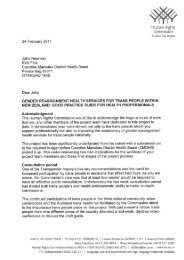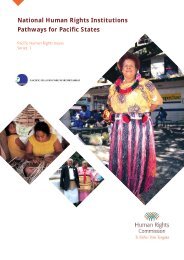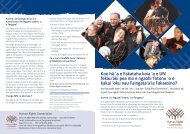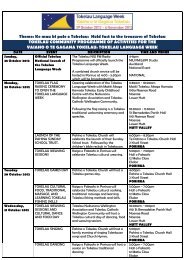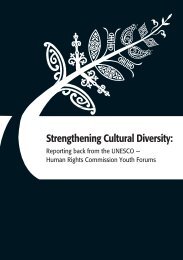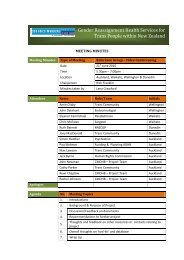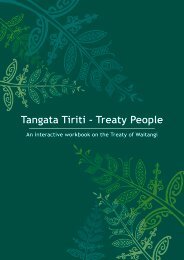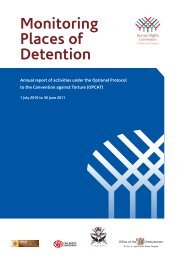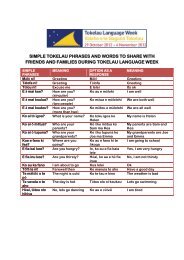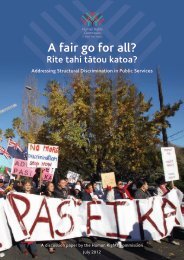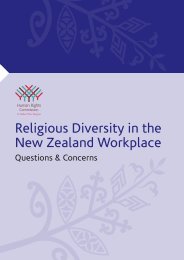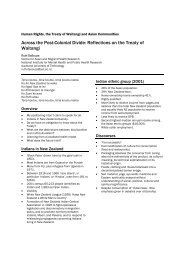Settling In Palmerston North and Feilding - Human Rights Commission
Settling In Palmerston North and Feilding - Human Rights Commission
Settling In Palmerston North and Feilding - Human Rights Commission
You also want an ePaper? Increase the reach of your titles
YUMPU automatically turns print PDFs into web optimized ePapers that Google loves.
Qualifications• <strong>Palmerston</strong> <strong>North</strong>’s overseas-born population is more highly qualified than the overseas-born across the country, with the opposite trueof <strong>Feilding</strong> (possibly because the overseas population is much older). <strong>In</strong> 2006, for Bachelor’s degrees <strong>and</strong> post-graduate qualifications,<strong>Palmerston</strong> <strong>North</strong> had 16% of its overseas-born in each category. <strong>Feilding</strong> was considerably lower, with 9% having Bachelor’s degrees <strong>and</strong>just 5% having post-graduate qualifications. The equivalent ‘all NZ’ figures are: 15% of the country’s overseas-born had Bachelor’s degrees<strong>and</strong> 8% of overseas-born had post-graduate qualifications.Language• The 2006 census showed that the following languages were among those able to be spoken by around 1% of the <strong>Palmerston</strong> <strong>North</strong> population:French, Yue, Samoan, <strong>North</strong>ern Chinese <strong>and</strong> German. <strong>In</strong> <strong>Feilding</strong>, around 1% of residents was able to speak French but only small numbersof people reported being able to speak other minority languages.• <strong>In</strong> 2006, 82% of <strong>Palmerston</strong> <strong>North</strong>’s overseas-born Chinese people assessed themselves as ‘able to have a conversation in English about alot of everyday things’ – a higher proportion than the 77% across New Zeal<strong>and</strong> – <strong>and</strong> 96% of the city’s overseas-born <strong>In</strong>dian population couldspeak English (also higher than the national proportion of 90%). 13Religion• Trends in religious affiliation in <strong>Palmerston</strong> <strong>North</strong> <strong>and</strong> <strong>Feilding</strong> are similar to those experienced nationally. <strong>In</strong> the 10 years between 1996 <strong>and</strong>2006, the majority of people affiliated with Christian religions but the proportion dropped between censuses. Conversely, the proportions givingthe next largest response (no religion) rose over that time. <strong>In</strong> general, the proportions affiliating to other religions also rose slightly over the 10years. <strong>In</strong> 2006, around 1% of <strong>Palmerston</strong> <strong>North</strong>’s population described themselves as Buddhist, Hindu or Muslim.• However, religious affiliation varied markedly by ethnic group. 14 <strong>In</strong> <strong>Palmerston</strong> <strong>North</strong> in 2006, the most numerous responses to the religionquestion by people who identified as Chinese were: no religion (61%), Christian (25%) <strong>and</strong> Buddhist (8%). <strong>In</strong> contrast, the majority of <strong>In</strong>dianpeople in the city, 54%, identified as Hindu, 21% as Christian <strong>and</strong> just 9% as having no religion. The situation was very different for Pacificpeoples, the large majority of whom were Christian. <strong>In</strong> <strong>Palmerston</strong> <strong>North</strong>, the 2006 census recorded that 75% of Samoan people, 59% of CookIsl<strong>and</strong>s Maori <strong>and</strong> 82% of Tongan people identified as Christian.Labour force status• Across New Zeal<strong>and</strong>, overseas-born people aged 15 <strong>and</strong> over were less likely to be in the labour force in 2006 than New Zeal<strong>and</strong> born (64%in the labour force compared with 71%). The same was true in both <strong>Palmerston</strong> <strong>North</strong> city <strong>and</strong> <strong>Feilding</strong> (66% <strong>and</strong> 61% respectively comparedwith 72% <strong>and</strong> 67% of New Zeal<strong>and</strong> born in those locations).• <strong>In</strong> 2006, 45% of <strong>Palmerston</strong> <strong>North</strong>’s overseas-born were employed full time, 17% were employed part time <strong>and</strong> 4% were unemployed. <strong>In</strong><strong>Feilding</strong>, 44% were employed full time, 15% were employed part time <strong>and</strong> just 2% were unemployed.• Across New Zeal<strong>and</strong> in 2006, 40% of people born in Asia were not in the labour force. <strong>In</strong> <strong>Palmerston</strong> <strong>North</strong> <strong>and</strong> <strong>Feilding</strong>, the proportions were37% <strong>and</strong> 27% respectively. Of the people born in the Pacific Isl<strong>and</strong>s, 35% were not in the labour force (30% in <strong>Palmerston</strong> <strong>North</strong> <strong>and</strong> 27% ofthose in <strong>Feilding</strong>).Occupation• The overseas-born residents of <strong>Palmerston</strong> <strong>North</strong> city were much more likely than New Zeal<strong>and</strong> born to be working in professional occupations(33% compared with 20% of New Zeal<strong>and</strong> born). Smaller proportions of overseas-born than New Zeal<strong>and</strong> born worked in all other types ofoccupation. <strong>In</strong> most cases, there was a 2–3 percentage point difference.• <strong>In</strong> 2006, professional occupations were the most common among Asian-born people (21% across New Zeal<strong>and</strong> <strong>and</strong> a higher 28% in<strong>Palmerston</strong> <strong>North</strong>). However, people born in the Pacific Isl<strong>and</strong>s were most likely to be in labouring occupations (21% nationally <strong>and</strong> 22% in<strong>Palmerston</strong> <strong>North</strong>). Professional occupations were the second most common among Pacific Isl<strong>and</strong> born living in <strong>Palmerston</strong> <strong>North</strong> City (at19%, considerably higher than the national proportion of 13%).SETTLING IN PALMERSTON NORTH AND FEILDING13These figures may not necessarily indicate a complete lack of English. Ability to speak a language isself-assessed in the Census. The question asked about the ability to ‘have a conversation about a lotof everyday things’. Some people may have assessed their ability more harshly than others <strong>and</strong> somemay have forgotten to tick English when answering the question.14These figures by ethnic group include people born in New Zeal<strong>and</strong>.15



